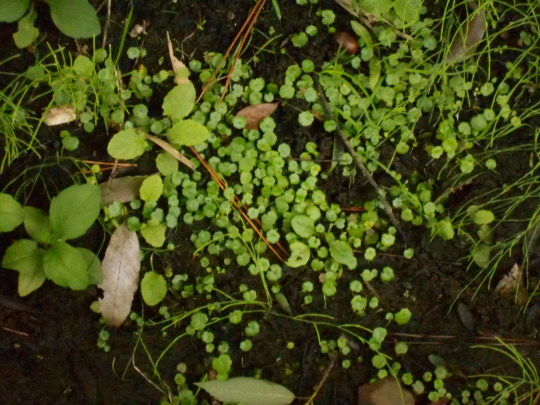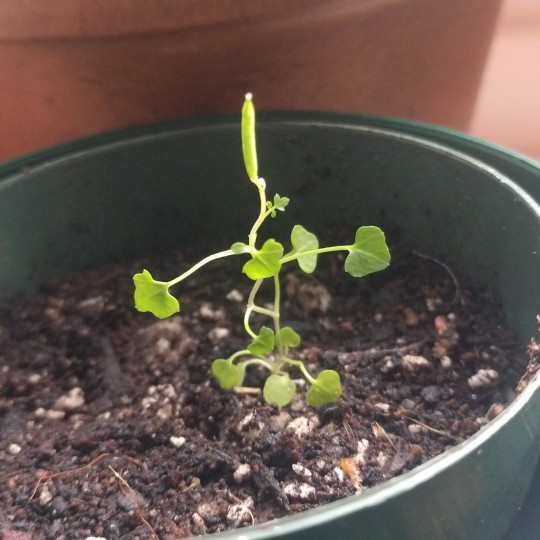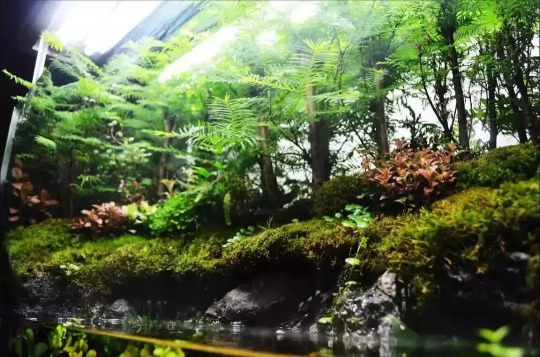#Hydrocotyle sibthorpioides
Text
Today's Haiku with Picture 182

Chidomegusa
moist in the moat
thickening
チドメグサ
堀でしっとり
茂りけり
Chidomegusa is a plant of the Araliaceae family and is said to be effective in stopping bleeding.
Scientific name: Hydrocotyle sibthorpioides
(2022.10.16)
#chidomegusa#moist in the moat#thickening#Araliaceae#stopping bleeding#Hydrocotyle sibthorpioides#Daikoin-temple#haiku
7 notes
·
View notes
Photo

Herbal Medicine Recipes To Cure Kidney Stones Disease
The ingredients of medicinal plants for curing kidney stones disease, ureter stones disease, and bladder stones disease are the same.
The similarity lies in the use of medicinal plant materials.
That medicinal plant’s materials have the properties of destroying or dissolving stones, dissolving (diuretic), relieving pain (analgesic), killing germs (antibiotics), relieving fever (antipyretic), and anti-inflammatory (anti-inflammatory).
Recipe I
Prepare 10 g dry or 30 g fresh tempuyung (Sonchus arvensis) leaves, 10 g dry or 30 g fresh meniran (Phyllanthus urinaria) plant, 15 g dry or 40 g fresh tapak liman (Elephantopus scaber) leaves, and 10 g dry or 30 g fresh cat whiskers (Orthosiphon aristatus) leaves.
Wash all ingredients, then poach in one liter of water.
After the water is only half, remove it, then strain it.
Drink in the morning, afternoon, and evening. 150 ml each.
Recipe II
Prepare 10 g of dry or 30 g of fresh tempuyung (Sonchus arvensis) leaves, 10 g of dry or 30 g of fresh meniran (Phyllanthus urinaria) plant, 10 g of dry or 30 g of fresh daun sendok (Plantago major) plant, and 15 dry roots of alang-alang (Imperata cylindrica).
Wash all ingredients, then poach in one liter of water.
After the remaining half of the water, remove it, then strain.
Drink three times a day, once drink 150 ml.
Recipe III
Prepare 10 g of dried or 25 g of fresh kembang bugang (Clerodendrum calamitosum) leaves, 10 g of dried or 25 g of fresh tempuyung (Sonchus arvensis) leaves, 15 g of dry or 40 g of fresh semanggi gunung (Hydrocotyle sibthorpioides) leaves, 10 g of dry or 30 g of fresh putri malu (Mimosa pudica) leaves, and 15 g of dry or 40 g fresh sambiloto (Andrographis paniculata) plant.
Wash all ingredients, then poach in one liter of water.
After the remaining half, lift, then strain.
Drink in the morning, afternoon, and evening. 150 ml each.
Recipe IV
Prepare 10 g of dry or 30 g of fresh keji beling (Strobilanthes crispa) leaves, 10 g of dry or 30 g of fresh meniran (Phyllanthus urinaria) plant, 40 g of dry bidara upas (Merremia mammosa) tuber, and 10 g of dry or 30 g of fresh daun sendok (Plantago major) plant.
Wash all ingredients, then poach in one liter of water.
After the remaining half of the water, remove it, then strain.
Drink three times a day, once drink 150 ml.
Recipe V
Prepare 10 g of dry or 30 g of fresh keji beling (Strobilanthes crispa) leaves, 30 g of dried roots of alang-alang (Imperata cylindrica), 10 g of dry or 30 g of fresh cat whiskers (Orthosiphon aristatus) leaves, and 10 g of dry or 30 g of fresh tapak liman (Elephantopus scaber) leaves.
Wash all ingredients, then poach in one liter of water.
After the remaining half, lift, then strain.
Drink in the morning, afternoon, and evening. Each 150 ml.
Recipe VI
Prepare 10 g dry or 30 g fresh tempuyung (Sonchus arvensis) leaves, 10 g dry or 30 g fresh tapak liman (Elephantopus scaber) leaves, 10 g dry or 30 g fresh sambiloto (Andrographis paniculata) plant, and 10 g dry or 30 g fresh putri malu (Mimosa pudica) leaves.
Wash all ingredients, then poach in one liter of water.
After remaining half, remove, then strain.
Drink three times a day, once drink 150 ml.
Recipe VII
Prepare 15 g of dry or 40 g of fresh jarong (Achyranthes aspera) plant, 10 g of dry or 30 g of fresh keji beling (Strobilanthes crispa) leaves, 10 g of dry or 30 g of fresh tapak liman (Elephantopus scaber) leaves, 10 g of dry or 30 g of fresh sambiloto (Andrographis paniculata) plant, and 40 g of dry roots of alang-alang (Imperata cylindrica).
Wash all ingredients, then poach in one liter of water.
After the remaining half of the water, remove it, then strain.
Drink three times a day, once drink 150 ml.
Recipe VIII
Prepare 10 g of dry or 30 g of fresh semanggi gunung (Hydrocotyle sibthorpioides) leaves, 10 g of dry or 30 g of fresh cat whiskers (Orthosiphon aristatus) leaves, 10 g of dry or 30 g of fresh tapak liman (Elephantopus scaber) leaves, and 10 g of dry or 30 g of fresh tempuyung (Sonchus arvensis) leaves.
Wash all ingredients, poach in a liter of water
After the remaining half, lift, then strain.
Drink three times a day, once drink 150 ml.
Recipe IX
Prepare 30 g of fresh papaya (Carica papaya) roots, 10 g of dry or 25 g of fresh gempur batu (Ruellia napifera) leaves, 10 g of dry or 30 g of fresh jarong (Achyranthes aspera) plant, and 30 g of fresh krokot (Portulaca oleracea) plant.
Wash all ingredients, poach in a liter of water.
After the remaining half, lift, then strain.
Drink three times a day, once drink 150 ml.
Recipe X
Prepare 10 g of dry or 30 g of fresh keji beling (Strobilanthes crispa) leaves, 30 g of fresh bidara upas (Merremia mammosa) tuber, 2-3 cobs and young corn hair.
Wash all ingredients, poach in a liter of water.
After the remaining half, lift, then strain.
Drink three times a day, once drink 150 ml.
Suggestions in the healing process of kidney stones disease with herbal medicine
Control stress
Drink at least two liters of water a day
Eat regularly with ideal portions
Avoid spicy food, acid, and soft drinks
https://english.tajba.com/herbal-medicine-recipes-to-cure-kidney-stones-disease/
0 notes
Text
My crocodile fern came with an interloper. At first I thought maybe it was part of the fern because it was growing right in the center. Well, it started to flower... so I decided to remove it.

I think it may be Hydrocotyle sibthorpioides (aka Lawn Marshpennywort). They're a shade plant (clearly as it was growing well shaded by a fern that receives only morning sun), and they can look pretty attractive in a pot... so I've put it in a humidity dome to compensate for the root damage, and we'll see if it survives.
Update: It survived and seems to be doing ok.
#it still has a little bit of root on it but I couldn't get in there without risking damaging the fern#so I kinda wiggled and yanked and it came out pretty easy#it's so itty bitty... if it stays this small I might end up putting it in the terrarium... if it survives#it actually doesn't seem all that upset right now#after an hour it looks much the same... which is what it looked like in the pot before I yanked it#so I think it's going to be ok#tbh... I'm getting into tiny plants
0 notes
Text
How to Make a Paludarium? ——Aquascaping Knowledge Get You Done!
Overall Configuration of Fish Tank
Fish Tank Size: 80*40*45 cm
Lighting: Adjustable LED Aquarium Light 5W/8W/11W/16W
Bottom Mud Material: Volcanic Stone, Light Stone, Thin Filter Sponge, Foam Plastic Cloth, Water Moss, Planting Soil (Peat soil, Vermiculite, Perlite)
Material: Dynasty Jade Stone, Tank divider, Landscaping Glue
Plants: Leucobryum juniperoideum, Giraldiella levieri, Metasequoia glyptostroboides, Hydrocotyle sibthorpioides, Ferns etc.
Finished Paludarium Appreciation
In the beginning, some hydroponic plants were cultivated in the water grass tank. Later, I wondered if it would be better to plant some wet plants on the water. I searched a lot of information on the Internet, so then the aquascaping journey began.
I believe everyone has a certain understanding of planted tanks and water tanks. But Paludarium that can both keep plants and raise fish is not so simple.
The first thing to consider is how to isolate the water surface from the land and try to maintain the size of the water substance as much as possible.
It was known that most of the Paludarium tanks' water substances are just a small piece you saw before, and there is less space for fish to move. If they can be improved, they can both raise fish and landscape plants. After considering several methods and materials, it was finally decided to choose a partition tank divider commonly used by everyone in the Vivarium to build a base, which was quite successful.
This kind of partition board divider can play a great role in the landscaping of the fish tank. In this Paludarium fish tank, its fast, convenient and practical functions are highlighted.
Firstly, splice the head and tail of the partition board together, and then cut the partition board into an appropriate size according to the fish tank. And as a base, place it at the bottom of the fish tank.
Then you can spread a layer of foam plastic on the partition to prevent the mud from falling through to the bottom and spreading.
Then in this order, you can lay the material on the partition:
From bottom to top:
Volcanic Stone, Light Stone, Thin Filter Sponge, Foam Plastic Cloth, Water Moss, Planting Soil (Peat soil, Vermiculite, Perlite)
After the foundation is done, the Dynasty Jade Stone can be gently inserted into the soil. Moss and other plants can be placed around it.
Here I put Leucobryum juniperoideum, Giraldiella levieri, Metasequoia glyptostroboides, Hydrocotyle sibthorpioides, Ferns and so on. The sticking tool I use is Aquarium Underwater Safe Glue.
When all the steps are completed, pour the water slowly into the blank space along the edge of the fish tank. (Note: Do not use the impact water flow here, It will lead to soil base damage.)
Finally, the fixed steps we know - water circulation, water purification. (Here is the same treatment as the general fish tank)
When the water quality of the fish tank is acceptable, you can put the cute fish in it.
Note: This fish tank is best not to raise too many fish or large and medium fish. The capacity of water is limited, so the environment in which the fish are grown must be considered.
Hope this article can be helpful and useful for fishkeeping lovers.
Please let us know in the comments below for more suggestions!
https://www.senzeal.com/blog/how-to-make-a-paludarium-aquascaping-knowledge-get-you-done-b0457.html


0 notes
Video
youtube
Cách trồng rau má hương thủy sinh hiệu quả
Rau má hương là một loại cây được sống chủ yếu trong môi trường hồ thủy sinh với tên khoa học là Hydrocotyle sibthorpioides. Cây được trồng nhiều ở khu vực Châu Âu và Châu Á với đặc điểm như hình cây dù nhỏ, có hình nón bung xòe ra và có màu xanh tươi nhỏ nhắn xinh xinh.
Có thể nói loại cây này có sức sống rất mãnh liệt, chúng bò rất nhanh chỉ sau vài tuần trồng. So với các loại cây khá thì chúng tăng trưởng khá nhanh, hấp thụ dinh dưỡng tốt. Chính vì thế, cây rau má hương rất dễ trồng, chỉ cần hồ có dinh dưỡng cao và không kén chọn ánh sáng. Tuy nhiên, vẫn còn nhiều người thất bại khi trồng loại cây này. Để chúng sinh trưởng, phát triển tốt, bạn hãy xem cách trồng rau má hương thủy sinh hiệu quả dưới đây nhé!
Đặc điểm rau má hương:
Họ: Scrophulariaceae
Kích thước: cao 2-5 cm, rộng 1-2 cm
Ánh Sáng: cao
Điều kiện nước: 68-82 º F, KH 0-10, pH 5-7
Vị trí: Tiền cảnh
Mức độ chăm sóc: Trung bình
Màu sắc: Xanh
Dạng: Hình dù
Khả năng: Sinh trưởng và phát triển tốt
"Cách trồng rau má hương thủy sinh hiệu quả
Địa chỉ: 64/5B Quốc Lộ 1A, P. Tân Thới Nhất, Quận 12
Số điện thoại: 0945 524 726
Website: http://bit.ly/35vEcC4"
0 notes
Text
Dwarf Pennywort Hydrocotyle Sibthorpioides Live Aquarium Plants BUY2GET1FREE*
http://dlvr.it/QsTQ38
0 notes
Photo

チドメグサ。止血作用がありますが、その作用はトロンビンなどに作用するのではなく、炎症を抑え血管の浸透に関係するようです。 hydrocotyle sibthorpioides. Japanese name is "stop bleeding". It a traditional herb for wound healing. caffeoylquinic acid may work. (Minato-ku, Tokyo, Japan)
0 notes
Text
Cách trồng rau má hương thủy sinh hiệu quả
Cách trồng rau má hương thủy sinh hiệu quả
Rau má hương là một loại cây được sống chủ yếu trong môi trường hồ thủy sinh với tên khoa học là Hydrocotyle sibthorpioides. Cây được trồng nhiều ở khu vực Châu Âu và Châu Á với đặc điểm như hình cây dù nhỏ, có hình nón bung xòe ra và có màu xanh tươi nhỏ nhắn xinh xinh.
Có thể nói loại cây này có sức sống rất mãnh liệt, chúng bò rất nhanh chỉ sau vài tuần trồng. So với các loại cây khá thì chúng…
View On WordPress
0 notes